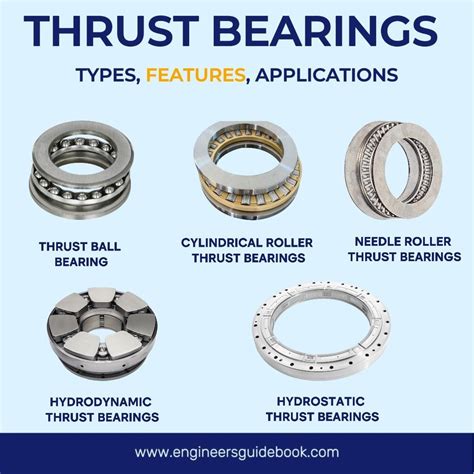Thrust Bearings: A Comprehensive Guide to Design, Selection, and Maintenance
Thrust bearings play a critical role in various industrial applications, supporting axial loads and facilitating rotary motion. This comprehensive guide delves into the intricacies of thrust bearings, exploring their design principles, selection criteria, and effective maintenance practices.
Understanding Thrust Bearings
Thrust bearings are specialized types of bearings that primarily support axial loads, acting perpendicular to the shaft axis. Unlike radial bearings, which accommodate radial loads, thrust bearings are designed to withstand forces acting along the shaft's axis.
There are several types of thrust bearings, each with unique characteristics and applications:
| Type |
Description |
| Ball thrust bearings |
Use ball elements to handle light to moderate axial loads. |
| Cylindrical roller thrust bearings |
Employ cylindrical rollers for heavy axial loads and high-speed applications. |
| Tapered roller thrust bearings |
Feature tapered rollers to accommodate high axial loads and combined loads. |
| Spherical roller thrust bearings |
Utilize spherical rollers for self-aligning capabilities and high axial load capacity. |
| Hydrostatic thrust bearings |
Utilize a pressurized fluid film to support axial loads, providing low friction and high load capacity. |
Design and Selection of Thrust Bearings
The design and selection of thrust bearings require careful consideration to ensure optimal performance and longevity. Key factors to consider include:

-
Load capacity: Determine the maximum axial load that the bearing must support under operating conditions.
-
Speed: Consider the rotational speed of the shaft and select a bearing with appropriate speed limitations.
-
Lubrication: Choose a bearing with the appropriate lubrication method, whether oil, grease, or fluid film.
-
Operating environment: Factor in external factors such as temperature, vibration, and contamination.
-
Mounting: Determine the type of mounting required (e.g., flange, foot, stud mount) and ensure compatibility with the machine design.
Effective Maintenance Strategies
Regular maintenance is crucial to extend the life of thrust bearings and prevent premature failures. Effective strategies include:

-
Visual inspection: Perform regular visual inspections to detect any visible signs of wear, damage, or contamination.
-
Condition monitoring: Implement condition monitoring techniques (e.g., vibration analysis, temperature monitoring) to identify potential issues early.
-
Proper lubrication: Ensure adequate lubrication by adhering to manufacturer recommendations for type and frequency of lubrication.
-
Shaft alignment: Check and correct shaft alignment regularly to prevent uneven loading and premature bearing failure.
-
Temperature monitoring: Monitor bearing temperatures to identify potential overheating or lubrication issues.
Tips and Tricks
Consider these tips and tricks to enhance the performance and longevity of thrust bearings:
-
Use tapered roller bearings for applications involving high axial loads and combined loads.
-
Select hydrostatic thrust bearings for high-load capacity and low friction applications, such as turbines and pumps.
-
Ensure proper mounting to prevent misalignment and premature bearing failure.
-
Monitor bearing temperatures to identify potential overheating or lubrication issues.
-
Establish a regular maintenance schedule to prevent downtime and extend bearing life.
Stories and Lessons Learned
The Case of the Noisy Thrust Bearing:
A manufacturing facility experienced excessive noise and vibration from its thrust bearings. Inspection revealed that the bearings were not properly lubricated, causing metal-on-metal contact and increased friction. Regular lubrication and maintenance resolved the issue, reducing noise and extending bearing life.

Moral: Proper lubrication is crucial to prevent bearing failures and excessive noise.
The Tale of the Underloaded Bearing:

An engineer installed a thrust bearing with a load capacity much higher than the actual operating load. The underloaded bearing suffered from fretting corrosion, a form of surface degradation caused by insufficient load. Replacing the bearing with a more appropriately sized one solved the problem.
Moral: Selecting a bearing with the correct load capacity is essential to avoid fretting corrosion and premature failure.
The Mystery of the Misaligned Bearing:
A machine operator noticed premature wear on one side of a thrust bearing. Investigation revealed that the shaft was misaligned, causing uneven loading and bearing damage. Correcting the shaft alignment resolved the issue and restored the bearing's longevity.
Moral: Proper shaft alignment is vital to prevent uneven loading and premature bearing failure.
Step-by-Step Approach to Thrust Bearing Maintenance
1. Preparation:
- Shut down the machine and isolate power sources.
- Collect necessary tools and materials.
- Use appropriate personal protective equipment (PPE).
2. Inspection:
- Perform a visual inspection of the bearing, checking for signs of wear, damage, or contamination.
- Check bearing temperatures to identify potential overheating.
- Ensure proper shaft alignment.
3. Cleaning:
- Clean the bearing and surrounding area using a suitable cleaning agent.
- Remove any debris or contamination that may compromise bearing performance.
4. Lubrication:
- Apply lubricant to the bearing as per manufacturer recommendations.
- Use the appropriate type and amount of lubricant.
- Ensure even distribution of lubricant throughout the bearing.
5. Reassembly:
- Reassemble the bearing and secure it properly.
- Ensure correct alignment and mounting practices.
- Tighten bolts or studs to the specified torque.
6. Testing:
- Start the machine and monitor bearing performance.
- Check for any unusual noises, vibrations, or temperature changes.
- Ensure proper lubrication and shaft alignment.
Why Thrust Bearings Matter
Thrust bearings play a crucial role in various industrial applications, providing the following benefits:
-
Support axial loads: Thrust bearings ensure the carrying capacity and stability of shafts in axial direction.
-
Facilitate rotary motion: Thrust bearings allow shafts to rotate smoothly while preventing axial displacement.
-
Reduce friction: Thrust bearings utilize rolling or sliding elements to minimize friction between contacting surfaces.
-
Extend equipment life: Properly maintained thrust bearings reduce downtime, increase equipment reliability, and extend the overall service life of machines.
Conclusion
Thrust bearings are essential components in various industrial machinery. Understanding their design principles, selection criteria, and maintenance practices is crucial for ensuring optimal performance and longevity. By applying effective strategies, tips, and tricks, and following a thorough maintenance approach, organizations can reap the benefits of reliable thrust bearing operation, minimizing downtime and maximizing equipment efficiency.
